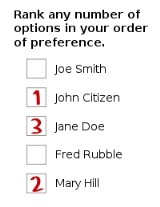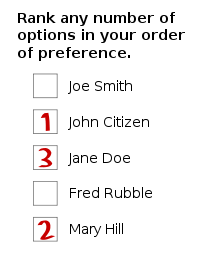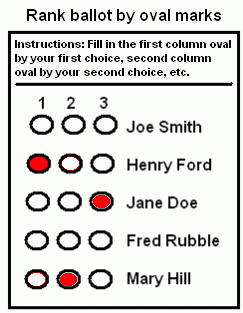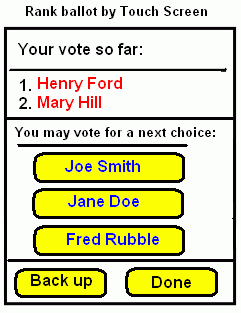
Preferential voting
Encyclopedia
Preferential voting is a type of ballot
structure used in several electoral systems in which voters rank candidates in order of relative preference. For example, the voter may select their first choice as '1', their second preference a '2', and so on. This contrasts with ballots used by methods which do not allow more than two-valued ranking of candidates (Yes or No; Yes to one and No to the others), such as plurality voting or approval voting
.
Preferential ballots are used in instant runoff voting (also known as the alternative vote), Condorcet method
s, the Borda count
and Bucklin voting
among many others for single-winner elections, as well as the single transferable vote
for multiple winner elections.
Preferential or ranked voting stands in opposition to rated voting, in which absolute rating categories or levels are used instead of relative preferences. Some examples of rated systems include Approval voting
, Majority Judgment
, Range voting
, and, in a degenerate sense, Plurality voting.
Written numbers: The voter writes a '1' beside their first choice, a '2' beside their second choice, and so on. This is the most common ballot design. Written numeric rankings are compact and easy to hand count.
Column marks: The voter writes marks beside their candidates in the columns of their number order. These ballots are easily counted by optical scanners. The choices are limited to the number of columns provided. In the image above, for example, the voter is limited to three preferences. So, the winner may still come up with less than 50% of the vote if there are fewer columns than candidates.
Written names: Similar to 'Written numbers' but in reverse, the numbers are written on the ballot and the voter must come up with the names of candidates beside them.
Touch screen: When voting is done by computer, a touch screen can be used. In the example above, voters arrange their selections in order by selecting candidates from the unranked area to the ranked area and then rearranging them with arrow keys or dragging. Selections can be removed or added again to and from the unranked and ranked categories until the voter is satisfied with their selections and rankings.
Some election rules may require voters to assign a ranking to all candidates or to a minimum number to be a valid vote. And most election rules disallow the use of tied-rankings.
elections, then it becomes more likely that many preference voting patterns will be unique to individual voters. For example, in the Irish general election, 2002
, the electronic votes were published for the Dublin North constituency. There were 12 candidates and almost 44,000 votes cast. The most common pattern (for the three candidates from one party in a particular order) was chosen by 800 voters, and more than 16,000 patterns were chosen by just one voter each.
The number of possible complete rankings
with no ties is the factorial
of the number of candidates, N, but with ties it is equal to the corresponding ordered Bell number and is asymptotic
to
In the case common to IRV in which no ties are allowed, except for unranked candidates who are tied for last place, the number of possible rankings for N candidates is precisely
which is asymptotic to (e-1)N! .
and independence of irrelevant alternatives
. The theorem does not directly apply to rated voting systems.
in multi-member constituencies.
Preferential voting is used in electing candidates to single-member electorates such as the Australian Federal House of Representatives
, state legislative assemblies (except in Tasmania) and local government municipalities.
Single transferable vote (STV) systems are used in electing candidates to multi-member electorates such as the Australian Senate
, State upper houses, Tasmania's State House of Assembly, the Australian Capital Territory
's legislative assembly, and some local government municipalities.
Ballot papers are counted according to a prescribed set of rules which set out the method used in the counting of the ballots and the distribution of preferences. Voters' preferences are now entered into computer systems that process the recorded votes to determine the results of the election. Copies of the transcribed data file used in the counting of the elections are published and made available for public inspection and scrutiny.
Supporters of the parties and individual candidates hand out "how to vote" cards (HTVs) at the entrance to polling stations or distributed with election material sent in the post, advising voters how to fill in their ballots to support that party or candidate. The information published on a how to vote card is a recommendation only and no voter is obliged to vote as published, but up to 80% of voters follow the recommendations of their preferred party or candidate. The proportion of voters that choose not to follow their preferred candidate's recommendations is called the "preference leakage".
The STV systems of some jurisdictions in Australia (e.g. the Senate) allow group voting ticket
s or "above the line voting" where a voter can, with a single mark, indicate support for a predefined set of preferences. This reduces the burden on voters, especially where there are large numbers of candidates and when a complete preference list is required to make a vote valid, so about 95% of voters use this option. Voters not wishing to use the "above-the-line-voting" option maintain the entitlement to indicate preferences for individual candidates; this is referred to as below-the-line voting. The allocation of predefined and individual voter preferences is important in determining the results of the election.
Ballot
A ballot is a device used to record choices made by voters. Each voter uses one ballot, and ballots are not shared. In the simplest elections, a ballot may be a simple scrap of paper on which each voter writes in the name of a candidate, but governmental elections use pre-printed to protect the...
structure used in several electoral systems in which voters rank candidates in order of relative preference. For example, the voter may select their first choice as '1', their second preference a '2', and so on. This contrasts with ballots used by methods which do not allow more than two-valued ranking of candidates (Yes or No; Yes to one and No to the others), such as plurality voting or approval voting
Approval voting
Approval voting is a single-winner voting system used for elections. Each voter may vote for as many of the candidates as the voter wishes. The winner is the candidate receiving the most votes. Each voter may vote for any combination of candidates and may give each candidate at most one vote.The...
.
Preferential ballots are used in instant runoff voting (also known as the alternative vote), Condorcet method
Condorcet method
A Condorcet method is any single-winner election method that meets the Condorcet criterion, which means the method always selects the Condorcet winner if such a candidate exists. The Condorcet winner is the candidate who would beat each of the other candidates in a run-off election.In modern...
s, the Borda count
Borda count
The Borda count is a single-winner election method in which voters rank candidates in order of preference. The Borda count determines the winner of an election by giving each candidate a certain number of points corresponding to the position in which he or she is ranked by each voter. Once all...
and Bucklin voting
Bucklin voting
Bucklin voting is a class of voting systems that can be used for single-member and multi-member districts. It is named after its original promoter, James W. Bucklin of Grand Junction, Colorado, and is also known as the Grand Junction system...
among many others for single-winner elections, as well as the single transferable vote
Single transferable vote
The single transferable vote is a voting system designed to achieve proportional representation through preferential voting. Under STV, an elector's vote is initially allocated to his or her most preferred candidate, and then, after candidates have been either elected or eliminated, any surplus or...
for multiple winner elections.
Preferential or ranked voting stands in opposition to rated voting, in which absolute rating categories or levels are used instead of relative preferences. Some examples of rated systems include Approval voting
Approval voting
Approval voting is a single-winner voting system used for elections. Each voter may vote for as many of the candidates as the voter wishes. The winner is the candidate receiving the most votes. Each voter may vote for any combination of candidates and may give each candidate at most one vote.The...
, Majority Judgment
Majority Judgment
Majority Judgment is a single-winner voting system proposed by Michel Balinski and Rida Laraki. Voters freely grade each candidate in one of several named ranks, for instance from "excellent" to "bad", and the candidate with the highest median grade is the winner. If more than one candidate has the...
, Range voting
Range voting
Range voting is a voting system for one-seat elections under which voters score each candidate, the scores are added up, and the candidate with the highest score wins.A form of range voting was apparently used in...
, and, in a degenerate sense, Plurality voting.
Ballot variations
There are a number of different but equivalent ways to design a ballot that allows voter to specify a set of rank preferences. |
 |
 |
 |
Written numbers: The voter writes a '1' beside their first choice, a '2' beside their second choice, and so on. This is the most common ballot design. Written numeric rankings are compact and easy to hand count.
Column marks: The voter writes marks beside their candidates in the columns of their number order. These ballots are easily counted by optical scanners. The choices are limited to the number of columns provided. In the image above, for example, the voter is limited to three preferences. So, the winner may still come up with less than 50% of the vote if there are fewer columns than candidates.
Written names: Similar to 'Written numbers' but in reverse, the numbers are written on the ballot and the voter must come up with the names of candidates beside them.
Touch screen: When voting is done by computer, a touch screen can be used. In the example above, voters arrange their selections in order by selecting candidates from the unranked area to the ranked area and then rearranging them with arrow keys or dragging. Selections can be removed or added again to and from the unranked and ranked categories until the voter is satisfied with their selections and rankings.
Some election rules may require voters to assign a ranking to all candidates or to a minimum number to be a valid vote. And most election rules disallow the use of tied-rankings.
Uniqueness of votes
If there is a large number of candidates, more common in STVSingle transferable vote
The single transferable vote is a voting system designed to achieve proportional representation through preferential voting. Under STV, an elector's vote is initially allocated to his or her most preferred candidate, and then, after candidates have been either elected or eliminated, any surplus or...
elections, then it becomes more likely that many preference voting patterns will be unique to individual voters. For example, in the Irish general election, 2002
Irish general election, 2002
The Irish general election of 2002 was held on Friday, 17 May 2002 just over three weeks after the dissolution of the 28th Dáil on Thursday 25 April by President Mary McAleese, at the request of the Taoiseach, Bertie Ahern...
, the electronic votes were published for the Dublin North constituency. There were 12 candidates and almost 44,000 votes cast. The most common pattern (for the three candidates from one party in a particular order) was chosen by 800 voters, and more than 16,000 patterns were chosen by just one voter each.
The number of possible complete rankings
Total order
In set theory, a total order, linear order, simple order, or ordering is a binary relation on some set X. The relation is transitive, antisymmetric, and total...
with no ties is the factorial
Factorial
In mathematics, the factorial of a non-negative integer n, denoted by n!, is the product of all positive integers less than or equal to n...
of the number of candidates, N, but with ties it is equal to the corresponding ordered Bell number and is asymptotic
Asymptotic analysis
In mathematical analysis, asymptotic analysis is a method of describing limiting behavior. The methodology has applications across science. Examples are...
to
-
 .
.
In the case common to IRV in which no ties are allowed, except for unranked candidates who are tied for last place, the number of possible rankings for N candidates is precisely
which is asymptotic to (e-1)N! .
Arrow's theorem
Arrow's theorem showed that no preferential voting system can obey certain desirable voting system criteria such as the majority criterionMajority criterion
The majority criterion is a single-winner voting system criterion, used to compare such systems. The criterion states that "if one candidate is preferred by a majority of voters, then that candidate must win"....
and independence of irrelevant alternatives
Independence of irrelevant alternatives
Independence of irrelevant alternatives is an axiom of decision theory and various social sciences.The word is used in different meanings in different contexts....
. The theorem does not directly apply to rated voting systems.
Australia
Australia uses a preferential voting system in single member constituencies and the single transferable voteSingle transferable vote
The single transferable vote is a voting system designed to achieve proportional representation through preferential voting. Under STV, an elector's vote is initially allocated to his or her most preferred candidate, and then, after candidates have been either elected or eliminated, any surplus or...
in multi-member constituencies.
Preferential voting is used in electing candidates to single-member electorates such as the Australian Federal House of Representatives
Australian House of Representatives
The House of Representatives is one of the two houses of the Parliament of Australia; it is the lower house; the upper house is the Senate. Members of Parliament serve for terms of approximately three years....
, state legislative assemblies (except in Tasmania) and local government municipalities.
Single transferable vote (STV) systems are used in electing candidates to multi-member electorates such as the Australian Senate
Australian Senate
The Senate is the upper house of the bicameral Parliament of Australia, the lower house being the House of Representatives. Senators are popularly elected under a system of proportional representation. Senators are elected for a term that is usually six years; after a double dissolution, however,...
, State upper houses, Tasmania's State House of Assembly, the Australian Capital Territory
Australian Capital Territory
The Australian Capital Territory, often abbreviated ACT, is the capital territory of the Commonwealth of Australia and is the smallest self-governing internal territory...
's legislative assembly, and some local government municipalities.
Ballot papers are counted according to a prescribed set of rules which set out the method used in the counting of the ballots and the distribution of preferences. Voters' preferences are now entered into computer systems that process the recorded votes to determine the results of the election. Copies of the transcribed data file used in the counting of the elections are published and made available for public inspection and scrutiny.
Supporters of the parties and individual candidates hand out "how to vote" cards (HTVs) at the entrance to polling stations or distributed with election material sent in the post, advising voters how to fill in their ballots to support that party or candidate. The information published on a how to vote card is a recommendation only and no voter is obliged to vote as published, but up to 80% of voters follow the recommendations of their preferred party or candidate. The proportion of voters that choose not to follow their preferred candidate's recommendations is called the "preference leakage".
The STV systems of some jurisdictions in Australia (e.g. the Senate) allow group voting ticket
Group voting ticket
Group voting tickets are a way to simplify preferential voting, usually in an election held under the single transferable vote or the alternative vote system....
s or "above the line voting" where a voter can, with a single mark, indicate support for a predefined set of preferences. This reduces the burden on voters, especially where there are large numbers of candidates and when a complete preference list is required to make a vote valid, so about 95% of voters use this option. Voters not wishing to use the "above-the-line-voting" option maintain the entitlement to indicate preferences for individual candidates; this is referred to as below-the-line voting. The allocation of predefined and individual voter preferences is important in determining the results of the election.
List of systems using preferential ballots
- Alternative vote top-upAlternative Vote Top-upThe Alternative Vote Plus , or Alternative Vote Top-up, is a semi-proportional voting system. AV+ was invented by the 1998 Jenkins Commission which first proposed the idea as a system that could be used for elections to the Parliament of the United Kingdom.As the name suggests, AV+ is an additional...
- Borda countBorda countThe Borda count is a single-winner election method in which voters rank candidates in order of preference. The Borda count determines the winner of an election by giving each candidate a certain number of points corresponding to the position in which he or she is ranked by each voter. Once all...
- Bucklin votingBucklin votingBucklin voting is a class of voting systems that can be used for single-member and multi-member districts. It is named after its original promoter, James W. Bucklin of Grand Junction, Colorado, and is also known as the Grand Junction system...
- Condorcet methodCondorcet methodA Condorcet method is any single-winner election method that meets the Condorcet criterion, which means the method always selects the Condorcet winner if such a candidate exists. The Condorcet winner is the candidate who would beat each of the other candidates in a run-off election.In modern...
s- Ranked PairsRanked PairsRanked pairs or the Tideman method is a voting system developed in 1987 by Nicolaus Tideman that selects a single winner using votes that express preferences. RP can also be used to create a sorted list of winners....
- Schulze methodSchulze methodThe Schulze method is a voting system developed in 1997 by Markus Schulze that selects a single winner using votes that express preferences. The method can also be used to create a sorted list of winners...
- Nanson's methodNanson's methodThe Borda count can be combined with an Instant Runoff procedure to create hybrid election methods that are called Nanson method and Baldwin method.- Nanson method :The Nanson method is based on the original work of the mathematician Edward J...
- Kemeny-Young methodKemeny-Young methodThe Kemeny–Young method is a voting system that uses preferential ballots and pairwise comparison counts to identify the most popular choices in an election...
- Ranked Pairs
- Coombs' methodCoombs' methodThe Coombs' method is a voting system created by Clyde Coombs used for single-winner elections in which each voter rank the candidates in order of preference. It is very similar to instant-runoff voting , a more common preferential voting system.-Procedures:Each voter rank-orders all of the...
- Single Transferable VoteSingle transferable voteThe single transferable vote is a voting system designed to achieve proportional representation through preferential voting. Under STV, an elector's vote is initially allocated to his or her most preferred candidate, and then, after candidates have been either elected or eliminated, any surplus or...
- Instant-runoff votingInstant-runoff votingInstant-runoff voting , also known as preferential voting, the alternative vote and ranked choice voting, is a voting system used to elect one winner. Voters rank candidates in order of preference, and their ballots are counted as one vote for their first choice candidate. If a candidate secures a...
(IRV) - single winner Single Transferrable Vote (STV)- Contingent voteContingent voteThe contingent vote is an electoral system used to elect a single winner, in which the voter ranks the candidates in order of preference. In an election, if no candidate receives an absolute majority of first preference votes, then all but the two leading candidates are eliminated and there is a...
- two round IRV- Sri Lankan contingent vote - two round, three rank IRV
- Supplementary Vote - two round, two rank IRV
- Contingent vote
- Instant-runoff voting
External links and further reading
- WeVote Ranked Choice Straw Poll Application on Facebook
- Toplak, Jurij. "Preferential Voting: Definition and Classification" Paper presented at the annual meeting of the Midwest Political Science Association 67th Annual National Conference, Chicago, IL, April 2009.
- Works of Richard S. Katz, Arend LijphartArend LijphartArend d'Angremond Lijphart is a world renowned political scientist specializing in comparative politics, elections and voting systems, democratic institutions, and ethnicity and politics. He received his PhD in Political Science at Yale University in 1963, after studying at the University of...
, Lauri Karvonen. - ACE Project: Single Transferable Vote
- ACE Project: Advantages and Disadvantages of STV
- A Handbook of Electoral System Design from International IDEA
- cassandra: open-source preferential voting software
- Electoral Design Reference Materials from the ACE Project
- Ranked Choice Voting in San Francisco
- Descriptions of some ranked-ballot voting methods by approval voting advocate Rob LeGrand


